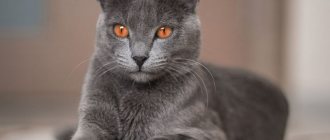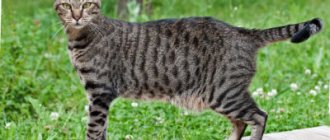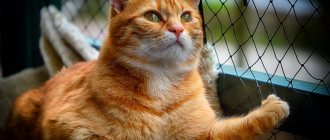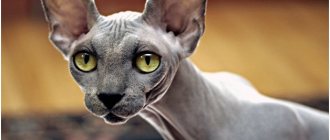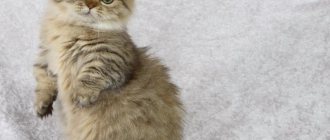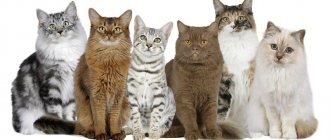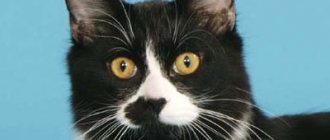What will you learn from the article?
- Shorthair cat breeds
- Semi-longhair cat breeds
- Long-haired cat breeds
- Hairless cat breeds
Fluffy and hairless, short-legged and long-legged, tailless and decorated with plumes - more than 100 breeds have already received official recognition, but literally every day new breeds of cats appear.
All cat breeds are divided into:
- Shorthair
- Semi-longhair
- Longhair
- Hairless cats
Siamese cat
- Height: 20-25 cm
- Body weight: 2.7-6.3 kg
- Lifespan: 15-20 years
- Temperament: smart, sociable, courageous and affectionate
The breed originated in Thailand (formerly called Siam) and was highly valued in the imperial court. Siamese cats are considered one of the oldest breeds in the world. They have a lean but muscular build, smooth color-point coats and expressive blue eyes.
Due to their short, low-shedding coat, Siamese cats are hypoallergenic , making them ideal for allergy sufferers.
These graceful cats are family-oriented and crave constant companionship. The breed is extremely vocal, territorial, interactive, playful and very intelligent.
Japanese Bobtail
- Height: 20-23 cm
- Body weight: 2.7-4.5 kg
- Lifespan: 9-15 years
- Temperament: Active, sociable, playful, intelligent, courageous, affectionate and territorial
As you can guess, Japanese Bobtails come from the Land of the Rising Sun. Their ceramic figurines are popular all over the world, and in Japan itself, maneki-neko figurines are considered a talisman of good luck.
These cute, funny pets are relatively rare, so they typically cost between $600 and $1,600 .
A distinctive physical feature of the Japanese Bobtail is its short, rabbit-like tail. These pets are sociable, playful, loyal, intelligent and active. The energetic Japanese Bobtails are especially good with children. They love to be the center of attention, adore human care and love to communicate.
Chinese Li Hua
- Height: 30-35 cm
- Body weight: 4.1-5.5 kg
- Lifespan: 12-15 years
- Temperament: Intelligent, independent, alert, active and friendly
The Chinese Li Hua, also known as the "dragon Li" and the "fox flower cat", is believed to have thrived in the wild for hundreds of years before being eventually domesticated. Today, she is admired for her unwavering devotion to her owners and loyalty to children.
The Chinese Li Hua was adopted by the Cat Fanciers Association only in February 2010.
This active cat breed can be taught tricks. The Chinese Li Hua is friendly to cats and dogs. She loves interactive toys and appreciates human attention. If you treat her politely and with respect, she will respond with affection and devotion.
Burmese cat
- Height: 25-31 cm
- Body weight: 2.8-6.3 kg
- Lifespan: 9-13 years
- Temperament: active, people-oriented, friendly, sociable, intelligent, affectionate and demanding
The ancestors of Burmese cats come from Burma (now Myanmar). There are two varieties: American and European. The European species (sometimes called the "traditional") is more slender, with a wedge-shaped head, small pointed ears, and almond-shaped eyes. Meanwhile, the American (or "modern") Burmese is noticeably stockier, with a wider head, ears with a wider base, and eyes that are much rounder and more expressive.
Most Burmese cats trust strangers and make friends easily . If you often have guests over, this kitty's outstanding social skills are sure to make a splash!
These magnificent cats are direct descendants of Siamese cats, which explains their chatty nature; however, their voices are softer and less demanding. Like their cousins, Burmese cats are playful, energetic, and very intelligent. They are very sociable and love to cuddle. In fact, these kittens are so affectionate that they are called the “ideal companion cats .
Singapura cat
- Height: 16-21 cm
- Body weight: 1.8-3.7 kg
- Lifespan: 11-15 years
- Temperament: energetic, outgoing, affectionate, friendly and curious
In their native Singapore, they are elevated to the status of a national treasure. There, Singapura cats are nicknamed “Kutsinta,” which translates to “love cat” or “the one I love.” Geneticists suggest that this breed shares ancestry with Siamese, Abyssinian and Burmese cats.
The Singapore cat is included in the Guinness Book of Records as the smallest breed of domestic cat.
Their short coat is usually ivory in color with dark brown markings. They are sociable and interactive cats that remain curious and playful long after they reach adulthood. Singapura cats are also incredibly assertive and talkative.
Korat
- Height: 25-36 cm
- Body weight: 2.7-4.6 kg
- Lifespan: 10-15 years
- Temperament: Loyal, energetic, playful and quiet
Korats are another breed native to Thailand. They are distinguished by their silvery blue fur, stunning emerald green eyes and muscular build. Despite their relationship with Siamese cats, these pets are very calm, do not like sharp sounds and have a habit of moving carefully and timidly.
Korats were once given to newlyweds in the hope of bringing good luck to their home and family.
Korats are gentle and affectionate cats that enjoy human company. They love attention and enjoy being involved in all aspects of the household: whether you're cooking dinner, cleaning the room, folding laundry, or getting ready to watch your favorite show, the Korat will be on hand to offer advice and lend a helping paw.
Unlike many other cat breeds, Korats are easy to train. Playful and friendly, Korats tend to get along well with everyone, including children and other cats and dogs. And Korats shed less than other cats.
Oriental shorthair cat
- Height: 23-28 cm
- Body weight: 3.6-4.6 kg
- Lifespan: 12-15 years
- Temperament: Curious, outgoing, affectionate, intelligent, loyal and extroverted
Oriental Shorthair cats were created by crossing Siamese cats with other domestic cat breeds. The goal was to maintain the sleek and slender shape of Siamese cats while offering a much wider selection of coat colors and patterns. Today there are approximately 300 color combinations .
Orientals are easily recognized by their slender and muscular build, long neck, angular face with almond-shaped eyes and large ears.
Although their appearance is unusual and many are unfamiliar with these felines, Oriental Shorthairs are not as rare as other exotic cat breeds such as the Khoa Mani or Japanese Bobtail.
These cats are famous for their good-natured, sociable, inquisitive and playful nature. Orientals love to be around people and furry friends. They are always talkative and make an unusual cry, similar to a horn. They meow when they want something or want to know what you are doing and where you are.
Breed cost
The price of an Asian tabby depends on several factors. First of all, the kitten’s parents and their external and physical characteristics play a role. Breeders especially value kittens with an ideal, correct skull structure and no spots on the surface of the fur. Accordingly, such kittens are more expensive than others in the litter.
It is also worth considering that such cats can participate in exhibitions, and if the kitten’s parents were prize winners, then the cost increases significantly. The kitten will be accompanied by a passport with information about the parents.
- The average cost of a regular kitten starts from 1000 rubles.
- Rarely do people give away kittens of this breed for free.
- The price of an Asian tabby cat is not stable and can depend on a number of reasons.
Turkish van
- Height: 25.4-35.6 cm
- Body weight: 4.5-9 kg
- Lifespan: 12-17 years
- Temperament: sociable, playful, active and intelligent
The Turkish Van originated in the area of the mountain Lake Van and is believed to have flourished away from human civilization for many centuries. These cats have a completely white body with multi-colored spots on the head and usually a solid tail of an identical shade. Surprisingly, this is not a white cat with colored spots, but on the contrary: the Turkish Van has one large white “spot” covering the entire body.
These felines are called "swimming cats" and love water and have waterproof coats. The Turkish Van will be happy to take part in water battles, play in the sink with the tap running, or simply enjoy a bath.
They have a slightly wedge-shaped head, medium-sized ears, and round eyes that are amber, blue, or a heterochromatic combination of both. Turkish Vans are incredibly intelligent, easy to train animals. Although these cats are affectionate towards their family members, they generally do not like hugs . Turkish Vans can lie next to you and will happily allow you to pet them, but they will not give in to your hands, preferring to be next to you rather than in your hands or lap.
Caraquet
Attempts to breed a new hybrid breed with steppe lynx genes have been going on since 2007, but only in 2014 did Russian felinologists manage to bring the long-term task to an end. Today it is officially recognized by TICA, as well as by the ICU registry in Russia. Translated from Turkish, Karaket means “black ear”.
Cats have a very individual appearance, reminiscent of the characteristics of their wild relatives. Namely, a strong muscular body, long limbs and large paws, high-set ears reminiscent of a lynx. The body of an adult animal can reach up to 50 cm in height and 90 cm in length, and the average weight is 10-12 kg. Due to the pigmented eyelids, the Caraquet's eyes look very bright and expressive. Two vertical and parallel marks located on the forehead are further evidence of his belonging to the freedom-loving steppe cats.
With their rather large build and “wild” pedigree, the animals are very peaceful and have an easy-going nature. They happily pick up the baton in active games, love children and get along well with other pets. They are unpretentious in their maintenance, quickly get used to the tray and can even be walked on a leash. They are not afraid of water and calmly tolerate the bathing procedure.
Turkish Angora
- Height: 23-35.5 cm
- Body weight: 3.7-6.8 kg
- Lifespan: 12-18 years
- Temperament: good-natured, sociable, playful and talkative
With its high intelligence and gorgeous white fur, it's easy to see why the Turkish Angora is a national treasure in its native country. For a time, these magnificent, intelligent, graceful cats were considered deaf and were so actively used in crossbreeding to create the Persian breed that they almost became extinct.
Turkish Angoras are descended from African wild cats. And this is the only domestic cat kept in Ankara zoos .
White fur is traditionally the most popular color of Turkish Angoras, but they can also be found in black, tan, brown and gray, as well as tabby, tortoiseshell and bi-color variations. The Turkish Angora is very intelligent. They are incredibly social cats who develop strong bonds with their family members. They happily accept other cats and dogs, and their naturally domineering nature quickly makes them dominant in the home menagerie.
History of cat colors
As you know, all modern domestic cats are descended from wild cats. Some breeds are from the inhabitants of the African continent, others are from wild European cats. They were all very different in color:
- The steppe cat (Felis Silvestris Lybica) was striped, with a gray, silver or sandy background. Depending on the subspecies, the color could change to light or dark sandy, and the stripes were replaced by spots;
- The European forest cat (Felis Silvestris) was distinguished by its beautiful grayish color with an ocher tint and dark, clear stripes.
The African steppe cat Felis Silvestris Lybica and its subspecies are considered the progenitors of all domestic cats
These cats served as the basis for the entire cat family. It is quite possible that during the formation process, interspecific crossing and gene mutations occurred, which further diversified the colors.
About 5,000 years ago, cats were domesticated by humans. Since then, thanks to selection and the same crossing, the colors of cats have become even more diverse.
Burmese cat
- Height: 20.3-28 cm
- Body weight: 4.5-5.9 kg
- Lifespan: 13-15 years
- Temperament: Even-tempered, affectionate, inquisitive and intelligent
This is an ideal choice for those looking for a cute and affectionate feline friend. The Burmese cat, also known as the sacred cat of Burma, is a large, long-haired breed with a heavy bone structure.
Like other color point cats, Burmese cats are white at birth . Coat color changes with age. They can take up to three years to reach their final coloration.
Burmese cats are playful, sociable and very jealous! If one of these cats chooses you as its owner, it will crave your affection and become jealous of other pets that steal your attention. They are also called “Velcro cats” .
Tennessee Rex
- Lifespan: 14-16 years
- Temperament: affectionate, sociable, quiet
- Colour: orange-cream, red and white with satin effect
- Weight: 3-5 kg
The Tennessee Rex, discovered in 2004, is the result of a natural mutation. Franklin Whittenburg of Tennessee had a stray cat who once gave birth to kittens, two of which were unusual. Due to a genetic mutation, these kittens had curly, satiny fur. The International Cat Association recognized the Tennessee Rex as a breed in 2009, although they have never made it to the championship level.
The Tennessee Rex is a very loving cat that enjoys spending time with family members. She loves to cuddle and lie on your lap. They are quiet cats, although they can make a little noise when hungry. But keep in mind that they need time to adapt to their new environment.
Persian cat
- Height: 25.4-38 cm
- Body weight: 3.2-5.5 kg
- Lifespan: 10-15 years
- Temperament: Even-tempered, independent, flexible, sensitive and playful
Persian cats are famous for their grand appearance and long, thick, shiny fur. These cats are believed to have existed exclusively in Persia (now Iran) and were then brought to Europe and crossed with other cat breeds, giving rise to the modern Persian breed. They were especially revered by royalty, including Queen Victoria, and Persian cats soon became popular in many countries.
Persian cats are one of the most ancient breeds of domestic cats with a thousand-year history. It is also one of the fluffiest long-haired breeds.
These furry pets love to lounge around, especially when they reach adulthood; This may be why some people call them “ furniture with fur . Don't be fooled by this reputation, however; these cats show a playful streak, especially when their family is ready to join in the fun.
Brief description of the Asian Tabby breed
When describing the Asian tabby, it is worth noting that cats are very easy to socialize with other animals, although they do not need it as much as other breeds.
It is quite possible to take them out for walks on a leash, but it is advisable to do this gradually, at first letting the kitten out of your hands only for a few minutes. This will allow him to gradually get used to the world around him, and soon he will be able to walk freely and without fear.
Khao-mani
- Height: 25.4-30.5 cm
- Body weight: 3.6-4.5 kg
- Lifespan: 10-12 years
- Temperament: sociable, affectionate and courageous
First mentioned in classical Thai literature as early as 1350, khao mani, meaning “white gem,” immediately gained popularity. These light-eyed cats were prized by Thai aristocrats, considered sacred and protected by the ruling class for centuries.
The Khao Mani is one of the most expensive cat breeds in the world with a price tag of around $7,000-$11,000 . These rare cats are said to bring good luck to their owners.
These cats are sociable, curious and completely devoted to their family. Energetic and quite intelligent, Kao Mani love interactive games and quickly get along with children and other playful pets.
Hybrid cats with big ears
Breeds bred by humans from wild cats are hybrid. Among them there are also many cats with big ears.
The Savannah breed originated from the long-eared Serval by crossing with the Abyssinian. She is the largest to date (in the first generation) and is still very rare, while the cat almost completely repeats the appearance of the Serval (longer tail and slightly smaller ears). Very rare and expensive, both to acquire and to maintain.
Savannah
The hybridization of the House with the Abyssinian gave rise to the wonderful Chausie breed, whose appearance is slightly reminiscent of the Caracal. The coat is plain, ticked in colors sorel (red), natural (gray), black grizzly (black with gray hairs), completely black. Quite difficult to reproduce, rare and expensive, but very beautiful breed with large ears ending in a characteristic tassel (not always).
Chausie
The crossing of the Caracal with the Abyssinian cat was finally crowned with success and gave humanity the Caracat breed. Almost no different in appearance from their wild ancestor. Large, very beautiful and quite socialized animals. Work on the breed is still in full swing. Roads and rare.
Caraquet
Mekong Bobtail
- Height: 17.8-23 cm
- Body weight: 3.6-4.5 kg
- Lifespan: 15-18 years
- Temperament: Outgoing, friendly, curious and energetic
The Mekong Bobtail is a cat breed that shares ancestry with the Siamese cat. It was named after the Mekong River, which flows through China, Laos, Cambodia and Vietnam. However, it was in Russia that the breed developed further before it became known in other countries.
Although Mekong Bobtails are recognized as a breed in their own right by the World Cat Federation, they are still classified as an "experimental breed" by the International Cat Association and the Cat Fancier's Association.
The similarity between Mekong Bobtails and Siamese cats is very pronounced due to their pointed fur and piercing blue eyes. But there is no confusion when they stand up and the characteristic pom-pom tail !
The Mekong Bobtail is an intelligent and quick-witted pet. He enjoys any vigorous play that involves climbing or jumping, but has a gentle and affectionate disposition. Due to their sociable nature, Mekong Bobtails do not like to be left alone for long periods of time and require attention.
Minskin
- Lifespan: 12-14 years
- Temperament: good-natured, friendly, intelligent, curious
- Color: all color variations
- Height: 17.8-20.4 cm
- Weight: 1.8-2.8 kg
- Comparable breed: Balinese cat, Somali cat, American Curl
The Minskin is a new breed of cat, bred in Boston in 1998. The first cat was born in July 2000, and by 2005 there were already 50 species of Minskins. Currently, the International Cat Association monitors the development of the breed.
Paul McSorley created the breed by crossing a Munchin with a Sphynx and refined it using a Devon Rex and a Burmese. The breeder intended to create a short-legged cat with fur on the limbs (tail, legs, nose, ears and face) with color variations found in breeds such as Siamese cats. Minskin is described as a corgi from the cat world , as he has sparse hair on his body and a hairless belly.
Minskins are affectionate, sociable and playful. But despite its energy, this breed cannot reach the physical heights of other cats due to its short, stocky legs.
Kurilian Bobtail
- Height: 25.4-35.6 cm
- Body weight: 3.6-5.5 kg
- Lifespan: 14-20 years
- Temperament: Playful, energetic, affectionate and friendly
The Kurilian Bobtail is native to Sakhalin Island and the Kuril Archipelago. This is a natural cat breed , meaning that it was created through natural selection and not through any human manipulation.
Kurilian Bobtails mature very slowly and reach full growth at about five years of age.
The active Kurilian Bobtail has a playful disposition and loves to hunt. This breed is also known for its ability to fish, and they have waterproof fur so they don't mind getting wet. Tiny pets such as hamsters and guinea pigs should be kept away from Kurilian Bobtails, who view all small creatures as potential prey. However, they usually get along well with other cats, dogs and children.
Care instructions
Many purebred pets have an innate tendency to a large number of diseases. This is due to the fact that breeders raise kittens exclusively for sale; for most of them, external data is much more important than the health of the kitten.
- Therefore, immediately after purchasing a pet, you need to take it to an appointment with a veterinarian, he will conduct a detailed examination and prescribe several vaccinations that will help protect the pet from various types of parasites.
- Anti-worm medications will also be prescribed, which are given to the kitten at intervals of 10 days until the parasites are completely eliminated, only if they were detected during examination. Medicines may also be prescribed to prevent their occurrence.
The issue of sterilization is not so pressing at present, because there are drops and tablets on sale that reduce the sexual desire of animals during the period of exacerbation. This allows you to avoid serious health and hormonal problems.
Raas
- Height: 29-36 cm
- Body weight: up to 6.8 kg
- Lifespan: 12-15 years
- Temperament: Playful, stubborn, energetic and independent
Raas is a breed of domestic cat that originated on the Indonesian island of Raas. Their physical characteristics are very similar to a wild jungle cat or leopard. These cats are larger than most other breeds. The raas has a square-shaped muzzle, a slightly pointed chin, erect ears, and dark green eyes.
There are many myths about them. One states that these felines have a sixth sense , and can only be kept by a certain group of people, such as clergy and community leaders. Another myth says that if a person decides to take a raas off the island, his luck will turn away.
Raas are energetic and playful, but seem to be afraid of humans and sometimes have difficulty adapting. However, it is quite possible to tame them, but you will have to be patient, since from time to time the Raas can be stubborn and grumpy.
A bit of genetics
For domestic cats, there are two basic colors: red and black. They form almost all colors in various combinations and variants. In turn, their manifestation is due to the pigment melanin. Eumelanin is responsible for black fur, and pheomelanin is responsible for red fur. Depending on the number of melanin granules in the hair, the color can be more or less intense.
All cat colors are formed using two pigments.
Black colors
Black colors are also called eumelanistic. The genes for black colors look like this:
- B - black;
- b - brown;
- bl - brown light.
There are genes responsible for color intensity. They look like dominant D (Dense) and recessive D (diluted).
They are combined in twos on a chromosome and are called alleles. So:
- a pair of explosives is responsible for the black color,
- bb - for chocolate and purple,
- blbl forms cinnamon and fawn.
Gene B is stronger than b, and b, in turn, is stronger than bl. Therefore, in a Bb pair the cat will be black, in a Bbl pair it will be chocolate, and in a Bbl pair it will be black again.
There is also an intensity gene on the chromosome. It will form the following colors:
- ВВDD - black solid (saturated),
- BBdd - blue,
- BBDd - black (since the D gene is dominant).
Many colors come from black
Red colors
The second name for red colors is pheomelanistic. The genes for red colors are dominant O and recessive O. In combination with genes D and d they produce:
- OD - rich red,
- Od - creamy.
The red color differs depending on the gender of the cat. This is due to its binding to the X chromosome. So, if a cat (XY) has the gene for red color, he will be red. In order for a cat (XX) to be red, it must have the red gene on both chromosomes.
Gene O is stronger than gene B. Therefore, the offspring of a red and black parent will be red.
Red color is the result of the action of pheomelanin
White color
The white color of cats is formed using the W (dominant) and w (recessive) genes. It acts by suppressing the genes of other colors. The W gene itself is not a color gene: it is precisely a suppressor gene that prevents the release of pigment.
If two cats with the WW (dominant) gene are crossed, the kittens will only be white. If you cross two cats with the Ww gene (such individuals are called heterozygous, that is, having two different alleles in one gene), then pigment may also appear in the offspring.
A big problem for white cats, especially blue-eyed ones, is deafness. It does not affect all animals, but occurs in almost 45% of cases. This occurs because the hearing loss gene is linked to the W (solid white) gene or the S gene (white spot gene).
Often, along with the white color gene, cats have blue or blue eyes.
White cats are not necessarily albinos
Albinism
It should be noted that white color and albinism are completely different phenomena caused by different processes. Albinism is designated by the “c” gene and is always recessive. There are two types of albinos: those with blue eyes (c) and those with red eyes (ca) . If gene C is dominant, albinism will not appear.
Tortoiseshell colors
The tortoiseshell color is also a sexual color and is characteristic of cats. This is because cats do not always have the red color gene on both X chromosomes. Sometimes the second one also contains the black color gene. In such cases, the turtle color is formed: black and red spots all over the body.
Tortoiseshell color is characteristic of females
Depending on the combination of genes on each chromosome, the colors in a tortoiseshell vary: for example, a tortoiseshell cat can be a fawn and blue, blue cream, chocolate and cinnamon (cinnamon) tortoiseshell, etc.
Tortoiseshell coloring is extremely rare, but appears in males. This happens if the sex chromosomes look like XXY, that is, a natural mutation gives the cat two X chromosomes.
Ticked colors
Ticking is the result of the action of the dominant agouti gene (A). It works as follows:
- At the first stage of hair growth, gene A allows intense pigment release and deep coloring of the hair (the color depends on the gene - black, red, etc.).
- During the second stage of wool growth, agouti reduces pigment production. The hair area grows lighter.
- These stages alternate, and as a result, light and dark stripes remain on the hair. This zoned coloring is called ticking.
Ticking can appear in both red and black base colors. Moreover, with less intense pigment production in black colors, the lightened area of the hair may take on a reddish or yellowish tint. From this we can conclude that ticked colors are not a mixture of “black” and “red” genes.
In pheomelanistic (red) cats with the A gene, the light stripes are usually yellowish, but can also be orange.
These colors were greatly influenced by the breeding factor. This can be revealed by the example of the brown tabby color. By nature, the brown ticking stripes in it are not too bright, but the selection of individuals made it possible to make them much more saturated.
Ticking appears due to the agouti gene
Non-agouti colors
A separate “subspecies” of ticked colors is “non-agouti” colors. They appear under the influence of the a gene, that is, the recessive agouti gene. Its action suppresses ticking and the hair is colored evenly. But there remains a small ticking area at the roots.
On non-agouti colors, the tabby pattern of black colors does not appear.
The aa allele cannot affect the ginger color gene, so ginger cats always have a tabby pattern. Some cats seem to be completely red, but this is the result of selection: breeders selected individuals whose pattern almost merged into a solid spot.
“Non agouti” colors look almost the same as solid colors
Tabby colors
Tabby colors are the manifestation of stripes of the main genetic color on a ticked background. The T gene is responsible for their manifestation. It causes certain areas of the fur to be colored evenly, while the remaining fur is ticked. Different genes are responsible for different types of tabbies. For example, T is for brindle, Tb is for classic, Ta is for Abyssinian.
Tabby patterns are as follows:
- tiger (mackerel);
- marble;
- rosette;
- spotted.
Abyssinian or ticked tabbies stand apart. These colors look like ticked hairs evenly spaced throughout the body. There are no stripes on the body, only on the face. They are often called agouti tabbies.
Tabby colors appear as a contrasting pattern against a ticked background
Piebald colors
Piebald colors are characterized by white spots that vary in size and location. The S gene is responsible for their manifestation. Piebald colors can be black, red, blue, ticked, etc.
There are the following types of piebald colors:
- van - formed by the Sw gene, dominant in relation to bicolor and harlequin;
- harlequin - Sp, dominant in relation to bicolor, recessive in relation to van;
- bicolor - Ss, recessive;
- calico and lightened calico, or tricolor;
- tuxedo or tuxedo;
- color-point bicolor - formed on color-point colors, making the back and sides of the animal darker;
- snowshu - characteristic only of the snowshu breed, formed with a large white spot stretching from the groin to the muzzle and white gloves;
- with white "gloves" (white spots on the feet) and spurs (spots up to the hock on the hind legs). The gl gene is responsible for them;
- with small white spots (buttons, medallions, white shirtfronts) - sisi, recessive to all genes responsible for white spotting, even to ss.
Sometimes the spots caused by the S gene can be so close that the cat appears almost white. Deafness is also associated with this gene.
Piebald colors are formed using white spots
Silver and cameo
These colors are the result of lightening a certain area of the hair with a white or yellowish (cream) color. In the first case, the color will be called silver, in the second - cameo. Gene I, or the inhibitor gene, is responsible for this factor. Silver colors are formed with the assistance of eumelanin, and cameo colors are formed with the assistance of pheomelanin.
There are many inaccuracies in studies of inhibitory gene colors. Until now, geneticists cannot say exactly how silver colors are formed. It is assumed that there are two genes responsible for their formation. But this theory has not yet been proven.
There are the following varieties of silver colors:
- smoke (smoky) - formed when the upper part of the hair is more than half dyed blue, black, purple or chocolate, and the root of the hair is almost white;
- silver tabby - a tabby pattern on silver ticking. The ticked areas are painted only at the tips, the rest is pale;
- shaded - about a third of the hair is dyed, two thirds are white;
- chinchilla (veiled) - only an eighth of the hair is dyed.
Silver colors look spectacular and mysterious
Dyeing only a certain part of the hair is called tipping.
Cameo colors are similar to silver (except for the shade) and have the following modifications:
- cameo shell (veiled) - 1/8 of a hair is dyed red;
- shaded cameo - only 1/3 of the hair is dyed;
- tabby cameo - red tabby drawing. The background is the tip of the hair painted with red ticking and a pale yellowish main part;
- cameo smoke - most of the hair is dyed red.
Cameo colors are delicate and dim
Golden and amber
Golden color is called when the root part of a cat's coat is yellow, and the rest is covered with golden ticking. There are two versions of the formation of this color:
- Color is formed under the influence of the dominant wb gene;
- The color is the result of the “golden agouti” gene.
Golden cats look like ticked cats
Golden has its own variations:
- golden chinchilla (veiled golden) - 1/8 of the hair is dyed, the rest is yellow;
- golden shaded - 1/3 of the hair is dyed;
- golden tabby - the tabby pattern is pale brown, the background is ticked at the tip and yellow at the base;
- smoky golden - more than half of the hair is dyed.
Another unusual and rare color is amber, amber. It is considered one of the variations of golden colors. It is believed that the gene responsible for the manifestations of amber (ee) is an eumelanin modifier. Therefore, the amber color cannot appear on a genetically ginger cat.
Amber color is quite rare
Acromelanistic colors (color point, Siamese or Himalayan)
Acromelanistic are colors in which only the face, paws, ears and tail are covered with color, and everything else is colorless. These spots, called points, form only on areas of the body with low temperatures, which is why color point colors are called temperature-dependent.
The C gene, which is responsible for color, is represented in the cscs allele in these colors. It is responsible for suppressing pigment production in warmer areas of the body.
There are also color-point colors with a tabby pattern (the result of the “joint work” of the T and cscs genes). This version of color point is called links or links point.
The color of a color point depends on temperature, and the color on points depends on the color gene and its intensity
Sepia and mink (Tonkinese)
Sepia (Burmese) and mink are also color points, since the pigmentation on the points is more intense than on the rest of the body. The ssv allele is responsible for sepia. In sepia, the color of the points is closer to the color of the body. Mink is the result of mixing the cs and sv genes and looks even less contrasting than sepia.
Burmese sepia is similar to color point
